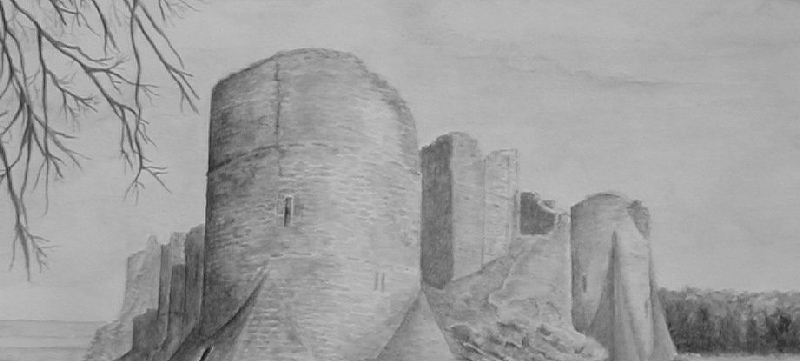


Standing high on a rock outcrop above the River Wye, Goodrich Castle is one of the
region's most striking ruins. A pale red sandstone keep was constructed in the middle
of the 12th century.
The original 'Godric's Castle' was established in 1095 by Godric
Marplestone who held the manor at the time of the Domesday Survey of 1086.
Today
the keep is 60 feet tall but it was originally much higher and would probably have
had with battlements.
The castle passed to William Marshal, 'The Elder' ,1st Earl
of Pembroke, in 1204 as a consequence of his loyal support for the unpopular King
John. It was under William's fourth son Walter, 5th Earl of Pembroke, that the surrounding
outer stone walls and turrets (pictured here) were completed between 1220 and 1245.
During
the latter part of the 13th century the owners, the de Valence family, (William de
Valence, Henry III's half-brother)transformed the simple tower into a great stronghold.
Four immense walls were built around the keep and at three corners they built cylindrical
towers with square bases. On the fourth corner a great gatehouse was constructed.
This led out to a semi-circular barbican which was designed to force any attackers
to make a right-angled turn to reach the gateway leaving them vulnerable to the missiles
and arrows of the defenders. The castle was also provided with drawbridges, great
doors and portcullises well supplied with loops for the castle's bowmen.
In the early
14th century, following the death of William de Valence's son Aymer, Goodrich was
held briefly by Hugh le Despencer, a powerful ally of the beleaguered king, Edward
II. However,
Goodrich saw little action through the remainder of the Middle Ages,
however, the outbreak of Civil War in England and Wales during 1642 changed all this.
During the first year of the war Goodrich was initially held for Parliament by the
Earl of Stamford.
Built on sturdy bedrock and surrounded by a deep moat the castle
was very well defended.
A chapel was built in the gatehouse and inside the walls
domestic buildings were constructed including a large hall, solar and kitchens.
These
buildings are well preserved. Although domestic buildings were included the castle
was primarily designed as fortress.
*** This site or it's owner has no connections with the English Heritage ***